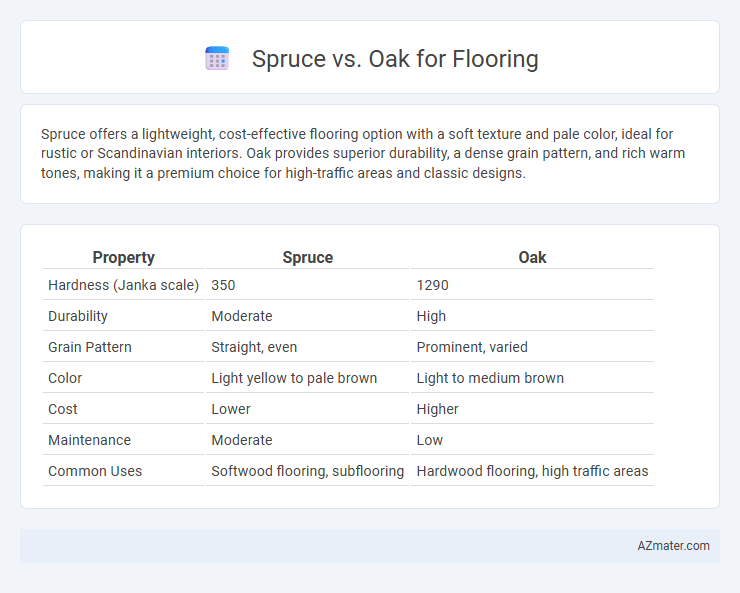Spruce offers a lightweight, cost-effective flooring option with a soft texture and pale color, ideal for rustic or Scandinavian interiors. Oak provides superior durability, a dense grain pattern, and rich warm tones, making it a premium choice for high-traffic areas and classic designs.
Table of Comparison
| Property | Spruce | Oak |
|---|---|---|
| Hardness (Janka scale) | 350 | 1290 |
| Durability | Moderate | High |
| Grain Pattern | Straight, even | Prominent, varied |
| Color | Light yellow to pale brown | Light to medium brown |
| Cost | Lower | Higher |
| Maintenance | Moderate | Low |
| Common Uses | Softwood flooring, subflooring | Hardwood flooring, high traffic areas |
Introduction to Spruce and Oak Flooring
Spruce flooring features a light, creamy color with subtle grain patterns, offering a soft yet durable surface ideal for residential spaces. Oak flooring, available in red and white varieties, boasts a rich grain texture and high hardness rating, making it suitable for high-traffic areas. Both options provide versatile aesthetics and reliable performance, but Oak's density generally surpasses that of Spruce, impacting durability and maintenance.
Appearance and Color Variations
Spruce flooring features a light, soft cream to pale yellow hue with subtle reddish or brown undertones, offering a clean, bright aesthetic ideal for Scandinavian and rustic interiors. Oak displays a broader color spectrum ranging from light tan and golden brown to deeper reddish and caramel shades, providing rich warmth and versatility for traditional or contemporary designs. The distinct grain patterns of oak, often pronounced with swirling or flecked textures, contrast with spruce's finer, straighter grain, influencing the visual depth and character of the flooring.
Durability and Hardness Comparison
Spruce flooring offers moderate durability with a Janka hardness rating around 460, making it more suitable for low-traffic areas, whereas oak, with a Janka hardness of approximately 1290 for red oak and 1360 for white oak, provides significantly greater resistance to dents and wear. Oak's dense grain structure ensures enhanced durability and longevity, ideal for high-traffic residential and commercial environments. Choosing oak over spruce flooring results in a more robust, long-lasting surface that withstands daily impacts better, maintaining its aesthetic appeal over time.
Cost Effectiveness: Spruce vs Oak
Spruce flooring typically costs less per square foot compared to oak, making it a budget-friendly option for large-scale installations. Oak, while more expensive upfront, provides greater durability and longevity, reducing replacement and maintenance costs over time. Considering cost effectiveness, spruce offers initial savings, whereas oak delivers better value through extended lifespan and enhanced wear resistance.
Installation Process and Ease
Spruce flooring offers a lightweight option that simplifies the installation process, making it easier to handle and cut with basic tools. Oak, being denser and harder, requires more effort and specialized tools during installation but provides superior durability and a longer-lasting surface. The ease of installing spruce makes it ideal for DIY projects, whereas oak is often preferred for professional installations due to its rigidity and permanence.
Maintenance and Longevity
Spruce flooring requires more frequent maintenance due to its softer wood grain, making it more susceptible to dents and scratches compared to the harder and more durable oak. Oak flooring offers superior longevity with its dense fiber composition, providing resistance to wear and tear which reduces the need for regular refinishing. Choosing oak flooring translates to lower maintenance costs and extended lifespan, ideal for high-traffic areas.
Environmental Impact and Sustainability
Spruce flooring offers a renewable option due to its rapid growth and lower carbon footprint compared to oak, which grows more slowly and requires extensive time to mature. Oak, being a hardwood, is more durable but often sourced from old-growth forests, raising concerns about deforestation and biodiversity loss. Choosing spruce supports sustainable forestry practices with quicker replenishment cycles, while oak's longevity can contribute to less frequent replacement, balancing environmental considerations.
Best Applications and Room Suitability
Spruce flooring offers a lightweight, softer wood ideal for low-traffic rooms such as bedrooms and living areas where warmth and a rustic aesthetic are desired. Oak provides exceptional durability and hardness, making it suitable for high-traffic spaces like kitchens, hallways, and commercial environments that require long-lasting wear resistance. Choosing oak or spruce depends on the balance between aesthetic preference and functional needs, with oak excelling in durability and spruce enhancing comfort and natural appeal.
Pros and Cons of Spruce Flooring
Spruce flooring offers a light, natural appearance with excellent acoustic properties and good insulation, making it suitable for cozy, warm interiors. Its softness makes it more prone to dents and scratches compared to harder woods like oak, resulting in higher maintenance needs over time. Spruce is typically more affordable but less durable than oak, limiting its use in high-traffic areas.
Pros and Cons of Oak Flooring
Oak flooring offers durability and timeless beauty, making it a popular choice for high-traffic areas due to its resistance to wear and dents. Its natural grain patterns and warm tones enhance aesthetic appeal but may require regular maintenance such as polishing and sealing to prevent moisture damage. Oak is generally more expensive than spruce, which is softer and less durable, but oak's longevity and value often justify the higher initial investment.

Infographic: Spruce vs Oak for Flooring
 azmater.com
azmater.com